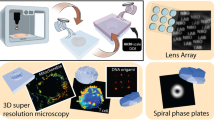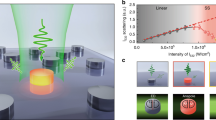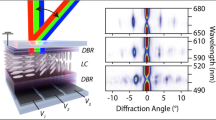Abstract
Volumetric integrated optical micro- and nanosystems are becoming the new frontier in photonics. Fine control over the material structure within a volume enables novel physical phenomena and previously unthinkable design freedom for spatial, spectral and temporal functions. For instance, materials have been tailored to control light through the use of metamaterials, disordered media and photonic crystals. Although periodic structures have been thoroughly investigated, volumetric aperiodic structures remain largely unexplored. The design of higher dimensional structures is of interest for controlling the multidimensional coherence function (which describes light fields) through diffraction, refraction, radiation and scattering. This report presents a three-dimensional scattering approach to the design of aperiodic volume optical elements and explores new functionalities making use of the now available three-dimensional degrees of freedom. Aperiodic volume elements that multiplex spatial and spectral information are numerically designed and experimentally demonstrated for the first time, hence expanding the traditional capabilities of volume holography, photonic crystals and diffractive optics.
This is a preview of subscription content, access via your institution
Access options
Subscribe to this journal
Receive 12 print issues and online access
$209.00 per year
only $17.42 per issue
Buy this article
- Purchase on Springer Link
- Instant access to full article PDF
Prices may be subject to local taxes which are calculated during checkout






Similar content being viewed by others
References
Yablonovitch, E. Inhibited spontaneous emission in solid-state physics and electronics. Phys. Rev. Lett. 58, 2059–2062 (1987).
John, S. Strong localization of photons in certain disordered dielectric superlattices. Phys. Rev. Lett. 58, 2486–2489 (1987).
Pendry, J. B., Schurig, D. & Smith, D. R. Controlling electromagnetic fields. Science 312, 1780–1782 (2006).
Leonhardt, U. Optical conformal mapping. Science 312, 1777–1780 (2006).
Li, J. & Pendry, J. B. Hiding under the carpet: a new strategy for cloaking. Phys. Rev. Lett. 1001, 203901 (2008).
Reicherter, M., Haist, T., Wagemann, E. U. & Tiziani, H. J. Optical particle trapping with computer-generated holograms written on a liquid-crystal display. Opt. Lett. 24, 294–296 (1999).
Grier, D. G. A revolution in optical manipulation. Nature 424, 810–816 (2003).
Lohmann, A. W. & Paris, D. P. Binary Fraunhofer holograms, generated by computer. Appl. Opt. 6, 1739–1748 (1967).
Herzig, H. P. Micro-Optics: Elements, Systems, and Applications (Taylor and Francis, 1997).
Jesacher, A., Fürhapter, S., Bernet, S. & Ritsch-Marte, M. Shadow effects in spiral phase contrast microscopy. Phys. Rev. Lett. 94, 233902 (2005).
Pavani, S. R. P. et al. Three-dimensional, single-molecule fluorescence imaging beyond the diffraction limit by using a double-helix point spread function. Proc. Natl. Acad. Sci. USA 106, 2995–2999 (2009).
Levy, U., Kim, H.-C., Tsai, C.-H. & Fainman, Y. Near-infrared demonstration of computer generated holograms implemented by using subwavelength gratings with space-variant orientation. Opt. Lett. 30, 2089–2091 (2005).
Tsai, C.-H., Levy, U., Pang, L. & Fainman, Y. Form-birefringent space-variant inhomogeneous medium element for shaping point-spread functions. Appl. Opt 45, 1777–1784 (2006).
Bartelt, H. Computer-generated holographic component with optimum light efficiency. Appl. Opt. 23, 1499–1502 (1984).
Nordin, G. P., Johnson, R. V. & Tanguay Jr, A. R. Diffraction properties of stratified volume holographic optical elements. J. Opt. Soc. Am. A 9, 2206–2217 (1992).
Borgsmüller, S., Noehte, S., Dietrich, C., Kresse, T. & Männer, R. Computer-generated stratified diffractive optical elements. Appl. Opt. 42, 5274–5283 (2003).
Cai, W., Reber, T. J. & Piestun, R. Computer-generated volume holograms fabricated by femtosecond laser micromachining. Opt. Lett. 31, 1836–1838 (2006).
Gerke, T. D. & Piestun, R. Aperiodic computer-generated volume holograms improve the performance of amplitude volume gratings. Opt. Express 15, 14954–14960 (2007).
Miller, D. A. B. Communicating with waves between volumes: evaluating orthogonal spatial channels and limits on coupling strengths. Appl. Opt. 39, 1681–1699 (2000).
Piestun, R. & Miller, D. A. B. Electromagnetic degrees of freedom of an optical system. J. Opt. Soc. Am. A 17, 892–902 (2000).
Piestun, R. & de Sterke, C. M. Fundamental limit for two-dimensional passive devices. Opt. Lett. 34, 779–781 (2009).
Brady, D., Chen, A. G. -S. & Rodriguez, G. Volume holographic pulse shaping. Opt. Lett. 17, 610–612 (1992).
Barbastathis, G. & Brady, D. J. Multidimensional tomographic imaging using volume holography. Proc. IEEE 87, 2098–2120 (1999).
Barbastathis, G., Balberg, M. & Brady, D. J. Confocal microscopy with a volume holographic filter. Opt. Lett. 24, 811–813 (1999).
Brady, D. & Psaltis, D. Control of volume holograms. J. Opt. Soc. Am. A 9, 1167–1182 (1992).
Glezer, E. N. et al. Three-dimensional optical storage inside transparent materials. Opt. Lett. 21, 2023–2025 (1996).
Kawata, S., Sun, H. B., Tanaka, T. & Takada, K. Finer features for functional microdevices. Nature 412, 697–698 (2001).
Deubel, M. et al. Direct laser writing of three-dimensional photonic-crystal templates for telecommunications. Nature Mater. 3, 444–447 (2004).
Born, M. & Wolf, E. Principles of Optics 7th edn (Cambridge Univ. Press, 1999).
Piestun, R. & Shamir, J. Control of wave-front propagation with diffractive elements. Opt. Lett. 19, 771–773 (1994).
Piestun, R., Spektor, B. & Shamir, J. Wave fields in three dimensions: analysis and synthesis. J. Opt. Soc. Am. A 13, 1837–1848 (1996).
Piestun, R. & Shamir, J. Synthesis of three-dimensional light fields and applications. Proc. IEEE 90, 222–244 (2002).
Stark, H. & Yang, Y. Vector Space Projections: A Numerical Approach to Signal and Image Processing, Neural Nets, and Optics (Wiley, 1998).
Gerchberg, R. W. & Saxton, W. O. A practical algorithm for the determination of phase from image and diffraction plane pictures. Optik 35, 237–246 (1972).
Fienup, J. R. Phase retrieval algorithms: a comparison. Appl. Opt. 21, 2758–2769 (1982).
Gerchberg, R. Super-resolution through error energy reduction. Optica Acta 21, 709–720 (1974).
Papoulis, A. A new algorithm in spectral analysis and band-limited extrapolation. IEEE Trans. Circ. Syst. 22, 735–742 (1975).
Wyrowski, F. & Bryngdahl, O. Iterative Fourier-transform algorithm applied to computer holography. J. Opt. Soc. Am. A 5, 1058–1065 (1988).
Bryngdahl, O. & Wyrowski, F. Digital holography – computer-generated holograms. Prog. Opt. 28, 1–86 (1990).
Brady, D. J. Optical Imaging and Spectroscopy (Wiley, 2009).
Acknowledgements
The authors thankfully acknowledge support from the National Science Foundation through the NIRT and IGERT programs (awards DMI-0304650 and DGE-0801680).
Author information
Authors and Affiliations
Contributions
R.P. conceived the idea and supervised the project. T.G. and R.P developed the model, algorithm and experimental plans. T.G. performed the designs, experimental fabrication, and characterization. R.P. and T.G. wrote the paper.
Corresponding author
Ethics declarations
Competing interests
The authors declare no competing financial interests.
Supplementary information
Rights and permissions
About this article
Cite this article
Gerke, T., Piestun, R. Aperiodic volume optics. Nature Photon 4, 188–193 (2010). https://doi.org/10.1038/nphoton.2009.290
Received:
Accepted:
Published:
Issue Date:
DOI: https://doi.org/10.1038/nphoton.2009.290
This article is cited by
-
Designing the collective non-local responses of metasurfaces
Communications Physics (2021)
-
Quasi-phase-matching-division multiplexing holography in a three-dimensional nonlinear photonic crystal
Light: Science & Applications (2021)
-
Azimuthal multiplexing 3D diffractive optics
Scientific Reports (2020)
-
Volume photoinscription of glasses: three-dimensional micro- and nanostructuring with ultrashort laser pulses
Applied Physics A (2020)
-
Liquid deposition photolithography for submicrometer resolution three-dimensional index structuring with large throughput
Light: Science & Applications (2013)



